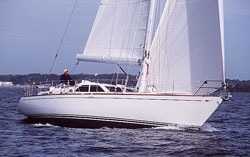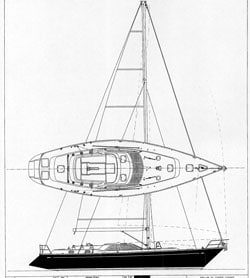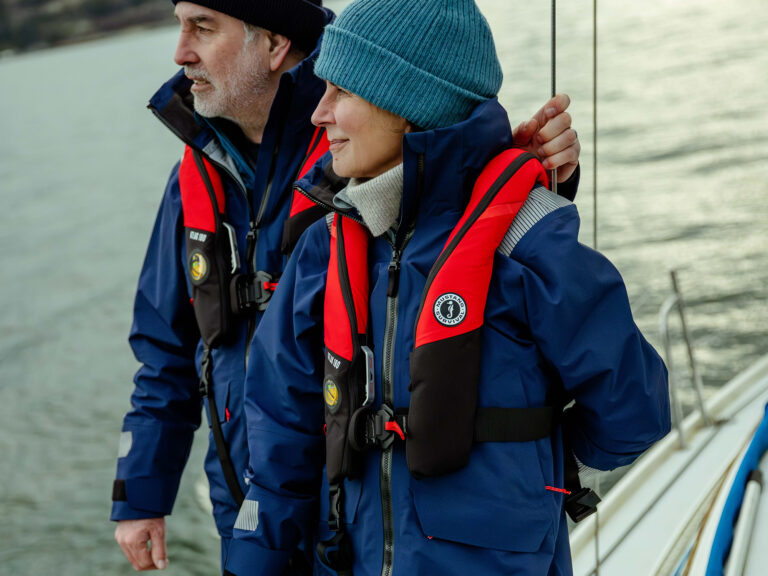
stellar.jpg

Stellar52-web.jpg
Take one look at the modern, streamlined, raised-deck saloon of the Stellar 52 Center Cockpit and you might assume that this newcomer sports a flat-canoe underbody, a spade rudder, and a wedge-shaped footprint, as many of today’s trends would have it. But on the contrary, here’s a very well-built sloop that’s anything but stereotypically contemporary.
From aloft, it’s easy to see her more traditional balanced ends and the fineness that merges with significant overhangs to give the hull a much more retro look. There’s also a moderate blend of rocker and deadrise in the underbody that lessens the pounding on a long beat to weather. In short, the raceboat frenzy toward flat sections and plank-edge straight buttock lines have been intentionally avoided by the team at S&S, and the result is a vessel that’s easy to look at and very comfortable under way.
Even the bow overhang is more than an aesthetic whim: It combines with ample freeboard and a fairly straight sheer to help keep the decks dry as well as make the cruiser’s ritual of anchor deployment and retrieval less of a threat to the shiny topsides gelcoat. The ample freeboard and substantial beam amidship provide lots of space in the main saloon as well as a good measure of form stability. The boat sports a big rig; still, moderate displacement and a sensible use of beam help keep her on her feet as the breeze builds.
The raised-saloon version of the Stellar 52 includes design work by Sparkman & Stephens as well as input from West Coast cruising-design guru Bob Perry. The attributes of such a pedigree have made the boat a head-turner at boat shows and the deck-saloon-category winner in this year’s CW Boat of the Year contest.
The Stellar 52 hull is actually an update of the proven Stevens 50, and it retains much of what made that design a favorite among serious cruisers and liveaboards. A swim-step transom extension has been added, and some appendage changes were made to enhance performance as well as shave off a couple of inches of draft. The keel and rudder have benefited from modern hydrodynamics research. An anvil bottom to the keel has lowered the lead, benefiting the vessel’s center of gravity (CG). According to calculations provided by Greg Matzat, S&S’s chief naval architect, the Stellar 52 has a limit of positive stability of 115 degrees, a stability index of 123 degrees, and a modest 31-percent ballast/displacement ratio.
Structure
When it comes to modern sailboat structure, there’s one thing that many designers and boatbuilders fail to fully appreciate: the value of a tough hull skin and its ability to separate a crew from the deep blue sea. Racing sailors often grumble about the performance costs of an overbuilt hull, but serious offshore cruisers realize that the errant tree trunk, partially submerged 55-gallon drum, or unexpected coral head may be held at bay by extra layers of fiberglass reinforcement. They see it as a few hundred pounds that are well spent.
The Stellar 52 has a no-nonsense solid hull of fiberglass-reinforced plastic (FRP) backed up with stringers and bulkheads that are fully bonded to the hull’s inner laminate. Vinylester resin is used for blister resistance, and layers of E-glass reinforcement are hand laid to ABS scantlings. The inward-turning hull flange provides a well-protected shelf to which the deck is mechanically fastened and laminated. The deck core is Al-600 Baltek balsa, with all key load areas and fastening locations kept as solid laminate and reinforced with backing plates.
The long, low-aspect-ratio fin keel is flared at the base and made of the same material as the hull. The thick FRP laminate encapsulates 12,000 pounds of lead ballast and evenly transfers the load into the hull skin itself. The keel combines with the heavy-duty laminate schedule to provide a very rugged and forgiving structure.
The boat’s 6-foot shoal-draft keel can be a big plus for those seeking to cruise relatively shoal waters, but it also means that the deep, skeg-hung rudder almost reaches the depth of the keel, and running aground carries the obvious implications. Fortunately, there’s a massive bronze casting that constitutes the armature of the skeg, and the rudderstock itself is made of 3-inch-diameter stainless steel. Even so, avoiding serious groundings is well worth a navigator’s diligence.
Under Sail & Power
One of the best legacies found aboard Sparkman & Stephens-designed sailboats is the logic of the sailhandling layout. As might be expected, the rig, rigging, and attendant sailhandling gear aboard the Stellar 52 are appropriately sized for the loads they’ll encounter. Tracks and winches are right where they belong, and the crew will find sailhandling, steering, and foredeck work to be expedited by the logical deck layout.
The double-spreader rig is practical, with a Forespar anodized aluminum spar, 1×19 wire rigging, and Navtec turnbuckles and hardware. There’s a Profurl headsail-furling system as well as an inner forestay, and the vessel derives all the benefits of a traditional double-headsail sloop.
The Leisure Furl in-boom mainsail furler is a convenient furling and reefing system that affords a crew push-button control of the 530-square-foot mainsail. There’s a bit of a learning curve associated with operating the system, and if the boom angle or outhaul tension is mishandled, furling snafus can occur.
Fortunately, if a furling or reefing problem does arise, the mainsail can still be lowered conventionally, and the problem can be sorted out once the squall has passed by.
The double-spreader, double-headsail rig allows a watchkeeper to cope with varied wind conditions; when the weather deteriorates, it allows a staysail or storm jib to be flown on the inner forestay.
Even with a light, 6- to 8-knot fluky southerly, the big rig nudged the sloop along at a pleasing 5 to 6 knots. When we bore off onto a broad reach, boat speed dropped, and it was clear that an asymmetric spinnaker or a traditional kite would be of value for such conditions.
Before long, the first few puffs of a reluctant sea breeze began to make their presence known, and the Stellar 52 was quick to respond. She conveyed an agile and responsive nature somewhat contradictory to her 38,000-pound displacement. Like most S&S designs, she proved quite able under sail, even in conditions that were anything but optimum for her displacement.
The Whitlock steering system had a pleasing, positive feel, and the sloop’s long run of keel and substantial rudder provided underpinnings that enhanced directional stability. Even though the shoal-draft keel would be less than optimum in a beat through heavy air, its contributions while reaching include effective yaw dampening and a seakindly motion, attributes appreciated by both a crew and an autopilot.
Attention to detail was quite obvious in the engine room and wherever else mechanical and electrical systems were housed. The main propulsion engine is a comparatively small 1.8-liter Yanmar 4JH2 that, with a boost from a turbocharger and intercooler, develops an impressive 100 horsepower. If this boat were more of a motorsailer, I’d prefer to see a larger-displacement, naturally aspirated engine. But her ability under sail should render the small-displacement, high-revving engine a fine solution.
The Fischer Panda generator, following on the same theme as the main propulsion plant, is small but power packed, producing 8 kilowatts. Using variable-rpm technology, the unit delivers enough juice to run AC appliances, charge the four large 8-D house batteries through a hefty combination charger/inverter, and still offer current for refrigeration and watermaker needs.
A Lovely Interior
The double-berth cabins in the bow and stern are accompanied by heads with showers, adequate hanging lockers, and bin and drawer storage space. There’s also a single-berth cabin on the port side just forward of the mast. The main saloon is dominated by a large table and a settee arrangement that’s more suitable for entertaining at anchor than providing sea berths for a weary off-duty watch.
The galley is tucked under a raised center cockpit and is fitted out with a four-burner Force 10 stove/oven, a Grunert holding-plate refrigeration system, and double sinks surrounded with Corian countertops. The sinks are placed over the engine space. On one hand, it’s nice to have the sinks closer to the centerline of the vessel; on the other, placing them above the engine room can contribute to unwanted moisture if the basin seal or a plumbing fitting fails. The counters are nicely fiddled.
There’s a chart table to port with a comfortable upholstered seat; however, the chart table’s fore-and-aft orientation will keep the navigator matching the heel of the boat. In port, the sizable nav station can do double duty as the ship’s office.
Fuel and water tankage, at 260 and 140 gallons respectively, ensure that fluids aren’t in short supply, but the allocation suggests a watermaker for a crew of more than two. There’s ample room, fuel, and power from the genset to run an efficient watermaker system to bolster the freshwater supply contained in the single stainless-steel tank. The standard configuration also provides for two fiberglass 30-gallon holding tanks.
Fit and Finish
The overall level of finish found aboard the Stellar 52 is top-notch. Tight joints, intricate shapes, and carefully applied varnish indicate an investment in labor hours that we don’t often see on today’s production boats, and this observation extends beyond the realm of woodwork. The same care in execution is evident in the plumbing and wiring as well as in the hard-to-get-at nooks and crannies of the bilge, where bulkhead tabbing and chainplate reinforcement reside. Take, for example, the carefully laminated installation of the fore-and-aft stringers, a feature that’s a vital part of hull integrity. They may not display the varnished glamour of a fancy saloon table, but it’s nice to see that quality-minded craftsmen build both tables and structural stringers.
Times have changed from the traditional S&S days of deep drafts, of snug sea berths, and of forepeaks stripped for sail and gear storage. Like most fine yacht-design firms, S&S listens carefully to the desires of the market. The Stellar 52 Center Cockpit reflects an attitude shift among boat buyers, a desire to enhance amenities and lessen the influence of offshore-dominated design. From my perspective, though, boat buyers are very lucky that firms like S&S just can’t help but keep seaworthiness and structural integrity on the front burner. They continue to bestow upon their designs attributes that befit those who like going to sea and may find themselves caught offshore in heavy weather.
Ralph Naranjo is Cruising World‘s technical editor and a Boat of the Year judge.








